Ojingeo Guk (Korean Squid Soup) is a light, comforting soup made with tender squid, Korean radish, and green onions. It’s quick to make and full of clean, savory flavor — a classic, everyday dish in Korean home cooking.
I grew up eating this soup both at home and at school in Korea, so it holds a special place in my heart. Recently, I saw it featured in the K-drama “When Life Gives You Tangerines”, and it instantly brought me back. This version is based on what I remember from childhood — simple, cozy, and deeply satisfying with a warm bowl of rice.
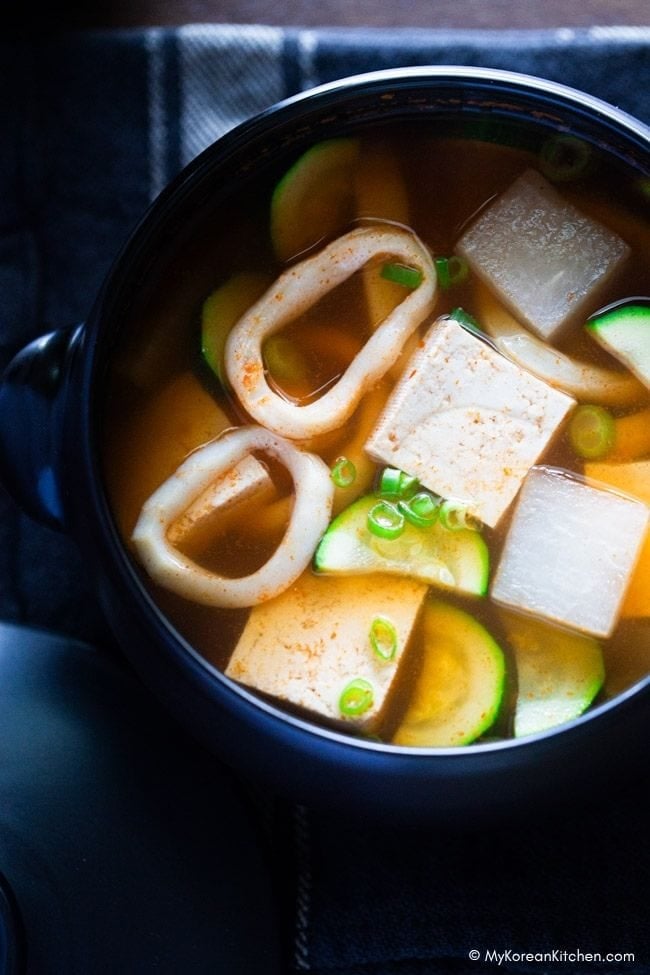
What Is Ojingeo Guk?
Ojingeo Guk (오징어국) is a light Korean soup made with squid — typically seasoned with soy sauce, garlic, and green onions. Depending on personal preference, it can include sliced radish, or chili flakes, and the flavor can range from clean and refreshing to gently spicy.
It’s the kind of soup that’s easy to overlook, but once you taste it, it hits in the most comforting way — especially with warm rice and a few Korean side dishes. There are different takes on it depending on who’s cooking, but they all share that signature ocean-sweetness from the squid and the cozy simplicity of a clear, nourishing broth.
Why You’ll Love This Soup
It’s quick, simple, and doesn’t require fancy ingredients — perfect for busy weeknights or when you want something warm and comforting without the fuss. And paired with a bowl of rice, it turns into a deeply satisfying, everyday Korean meal.

What You’ll Need
Korean Soup Stock
- 10g (0.4 oz) dried kelp
- 30g (1.1 oz) dried anchovies, heads and guts removed
- 6 cups water
Main Add-ins
- 2 small squid (about 240g / 8.5 oz total), cleaned and cut into rings or strips the size of an adult’s little finger
- 75g (2.6 oz) zucchini (about ½ a zucchini), sliced into half-moons
- 300g (10.6 oz) Korean radish, sliced into even slabs, about 1 cm (⅜ inch) thick
- 200g (7 oz) tofu (optional), sliced into even slabs
- 15g (0.5 oz) green onion, green part only, thinly sliced
- 1½ Tbsp Korean soup soy sauce (guk-ganjang)
Soup Seasonings
- 1 Tbsp mirin
- 1 Tbsp Korean fish sauce
- ½ Tbsp minced garlic
- ½ Tbsp Korean chili powder (finely ground)
- 1 tsp Korean chili paste (gochujang)
- ⅛ tsp fine salt, or to taste
* If you want to learn more about Korean ingredients, check out my Korean ingredients post.
How to Make Ojingeo Guk
1. Make the Korean Soup Stock
In a medium pot, combine the dried kelp and dried anchovies with 6 cups of water. Bring to a gentle boil over medium heat, then simmer for 10 minutes. After 10 minutes, remove the kelp — leaving it in too long can make the stock taste bitter. Continue simmering the anchovies for another 10 minutes to deepen the flavor. Once done, strain the stock and discard the solids.
New to Korean stock? You can follow my full tutorial here: How to Make Korean Soup Stock
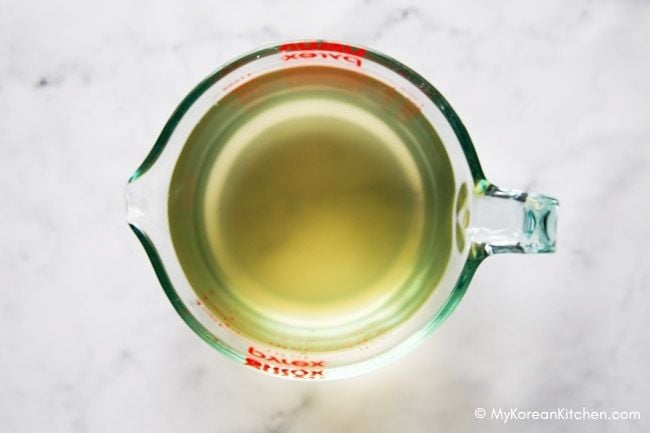
2. Marinate the Radish
Place the cubed radish in a bowl and season with Korean soup soy sauce (guk-ganjang). Let it sit for 10 to 15 minutes—this early step helps the radish absorb flavor, so each bite turns out more seasoned and delicious.
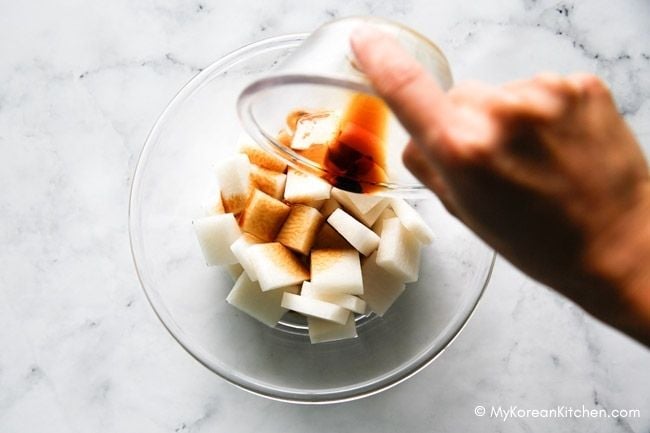
3. Mix the Soup Seasonings
While the radish is resting, mix the soup seasonings in a small bowl. Having them ready to go makes the next step quicker and easier.
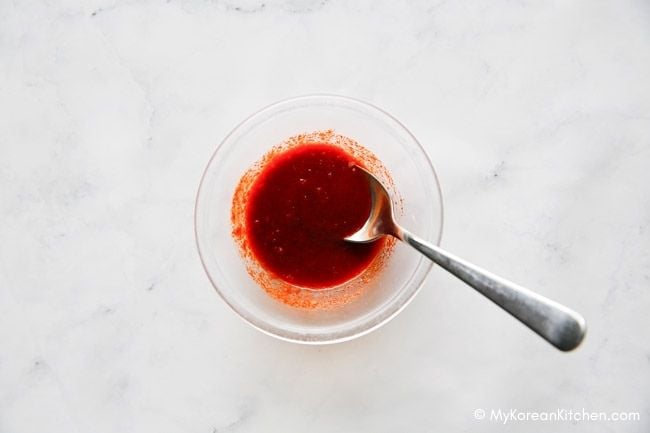
4. Build the Soup Base
Bring the prepared soup stock (from step 1) to a boil over medium-high heat. Once it’s boiling, add the seasoned radish and the soup seasonings. Reduce the heat to medium and let it simmer gently so the flavors can meld.
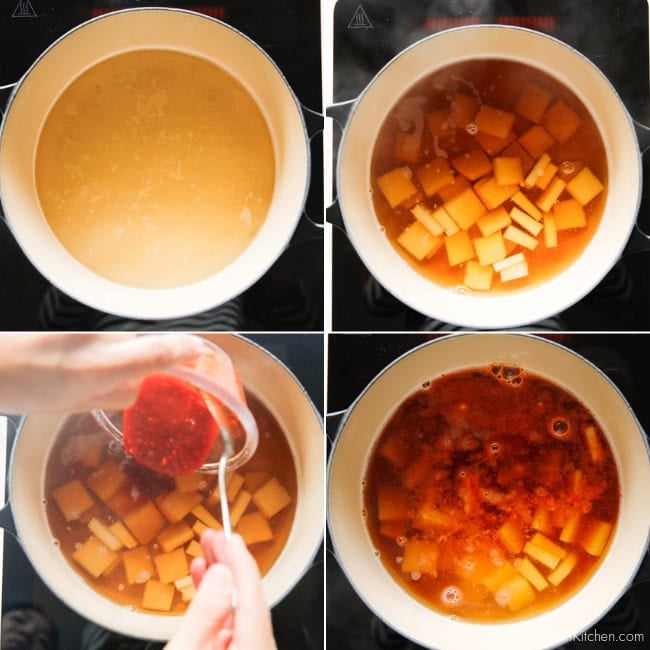
5. Add the Main Ingredients
When the radish is about halfway tender, add the squid, zucchini, and tofu. Let everything simmer together until the squid is cooked through, the vegetables are tender, and the flavors have melded nicely.
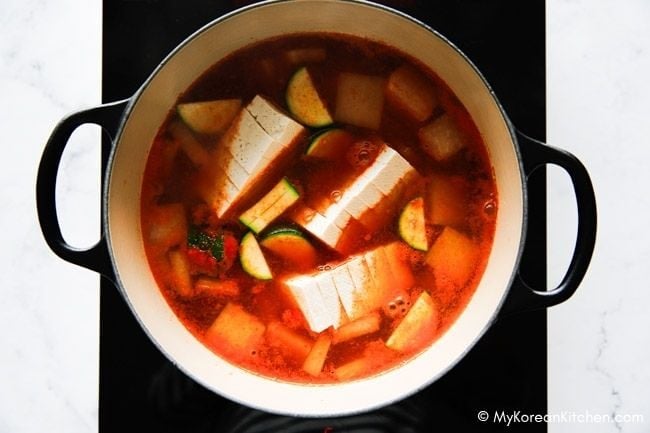
6. Finish and Serve
Taste the soup and season with a little salt, if needed, to suit your taste. Just before serving, garnish with chopped green onion. Enjoy hot with a bowl of steamed rice and a few simple Korean side dishes on the side.
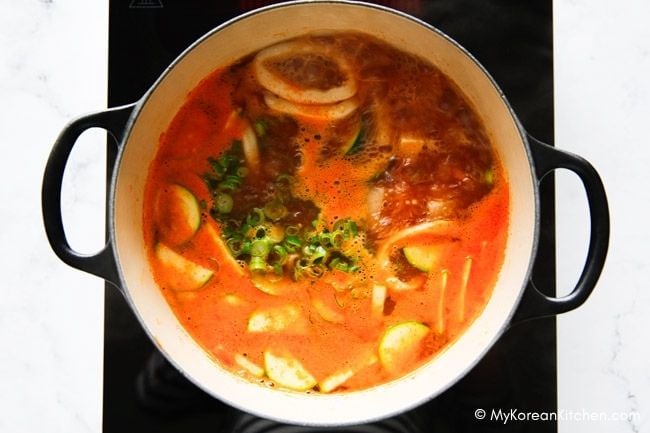

My Best Cooking Tips
Taste the radish before using in the soup.
Not all radishes are the same—some can taste bitter. If yours does, give it a quick blanch in plain boiling water (no seasoning) for 1 to 2 minutes before seasoning. Just be careful not to overdo it—over-blanching can make the radish too soft and affect the final texture of the soup.
Using frozen squid?
Don’t thaw it all the way—it’s much easier to slice when still partially frozen, and less likely to tear or get mushy.
Prep while the stock simmers.
While the soup stock is gently simmering, go ahead and prep the rest of your ingredients. It’ll keep things flowing smoothly and help everything come together more efficiently.
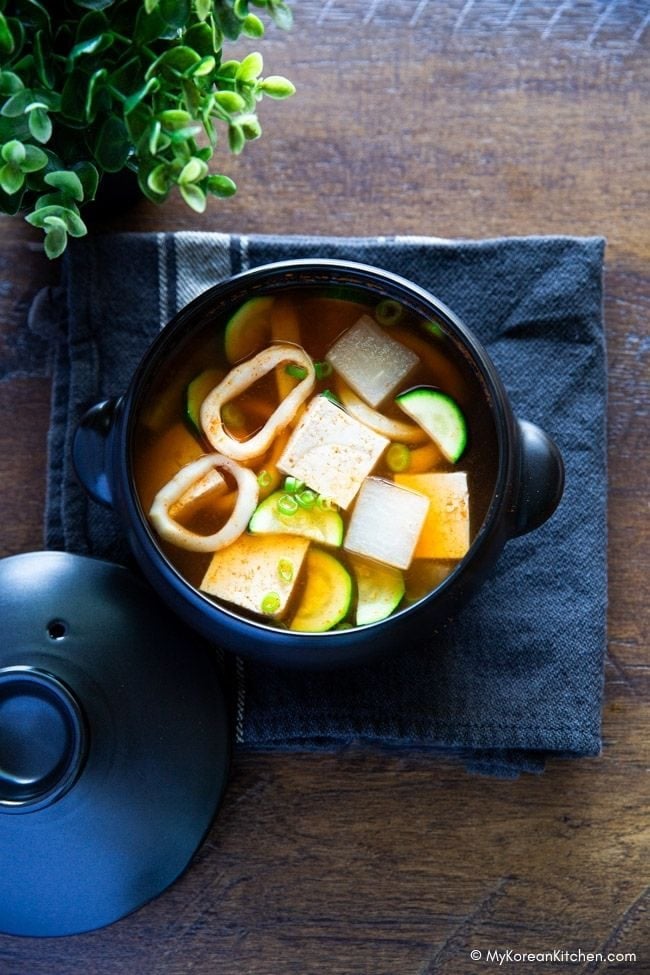
Looking for More Korean Soups? Try These!
- Korean Seaweed Soup (Miyeok Guk) – A light and nutritious soup made with seaweed and beef, traditionally enjoyed on birthdays and after childbirth for its health benefits.
- Kimchi Jjigae (Kimchi Stew) – A hearty and spicy stew featuring aged kimchi, pork belly, tofu, and mushrooms, perfect for a comforting meal.
- Doenjang Jjigae (Soybean Paste Stew) – A savory stew made with fermented soybean paste, tofu, and vegetables, offering deep umami flavors.
- Yukgaejang (Spicy Beef Soup) – A spicy and robust soup with shredded beef, scallions, and vegetables, known for its invigorating qualities.

Korean Soup Stock
- ▢ 10 g dried kelp (0.4 oz)
- ▢ 30 g dried anchovies (1.1 oz), heads and guts removed
- ▢ 6 cups water
Main Add-ins
- ▢ 2 small squid (about 240g / 8.5 oz total), cleaned and cut into rings or strips the size of an adult’s little finger
- ▢ 75 g zucchini (about 1/2 a zucchini), sliced into half-moons
- ▢ 300 g Korean radish (10.6 oz), sliced into even slabs, about 1cm (3/8inch) thick
- ▢ 200 g tofu (7 oz), (optional), sliced into even slabs
- ▢ 15 g green onion (0.5 oz), green part only, thinly sliced
- ▢ 1 1/2 Tbsp Korean soup soy sauce (guk-ganjang)
In a medium pot, combine the dried kelp and dried anchovies with 6 cups of water. Bring to a gentle boil over medium heat, then simmer for 10 minutes. After 10 minutes, remove the kelp — leaving it in too long can make the stock taste bitter. Continue simmering the anchovies for another 10 minutes to deepen the flavor. Once done, strain the stock and discard the solids.
New to Korean stock? You can follow my full tutorial here: How to Make Korean Soup Stock
Place the cubed radish in a bowl and season with Korean soup soy sauce (guk-ganjang). Let it sit for 10 to 15 minutes—this early step helps the radish absorb flavor, so each bite turns out more seasoned and delicious.
While the radish is resting, mix the soup seasonings in a small bowl. Having them ready to go makes the next step quicker and easier.
Bring the prepared soup stock (from step 1) to a boil over medium-high heat. Once it’s boiling, add the seasoned radish and the soup seasonings. Reduce the heat to medium and let it simmer gently so the flavors can meld.
When the radish is about halfway tender, add the squid, zucchini, and tofu. Let everything simmer together until the squid is cooked through, the vegetables are tender, and the flavors have melded nicely.
Taste the soup and season with a little salt, if needed, to suit your taste. Just before serving, garnish with chopped green onion. Enjoy hot with a bowl of steamed rice and a few simple Korean side dishes on the side.
My Best Cooking Tips
Taste the radish before using in the soup.
Not all radishes are the same—some can taste bitter. If yours does, give it a quick blanch in plain boiling water (no seasoning) for 1 to 2 minutes before seasoning. Just be careful not to overdo it—over-blanching can make the radish too soft and affect the final texture of the soup.
Using frozen squid?
Don’t thaw it all the way—it’s much easier to slice when still partially frozen, and less likely to tear or get mushy.
Prep while the stock simmers.
While the soup stock is gently simmering, go ahead and prep the rest of your ingredients. It’ll keep things flowing smoothly and help everything come together more efficiently.
If you want to learn more about Korean ingredients, check out my Korean ingredients post.
The nutrition information shown is an estimate provided by an online nutrition calculator. It should not be considered a substitute for a professional nutritionist’s advice.
I love hearing how you went with my recipes! Rate this recipe with a comment below and tag me on Instagram @MyKoreanKitchen.







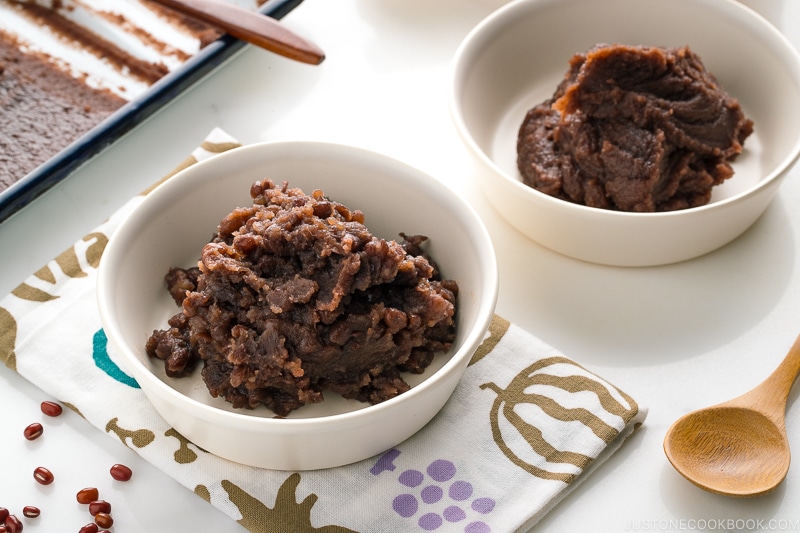



 English (US) ·
English (US) ·